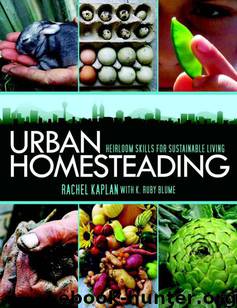Urban Homesteading by Kaplan Rachel & Blume K. Ruby

Author:Kaplan, Rachel & Blume, K. Ruby [Blume, K. Ruby]
Language: eng
Format: epub
Publisher: Skyhorse Publishing
Published: 2011-04-27T04:00:00+00:00
Food As Medicine
Eating is one of life’s pleasures. Good food is sensuous, comforting, nourishing, and delicious. When we eat foods that have no history or are full of processed ingredients we can’t pronounce or recognize or digest, slapped together from low-quality ingredients, our bodies take the hit. Instead of thinking of food as “fuel for the engine,” something we eat on the run, we can think of our food as medicine, the soil from which we grow our healthy bodies. Eating pure, fresh, nourishing food is our best health insurance and one of the surest ways to honor our bodies. Eating “close to the ground” or lower down on the food chain has the greatest impact on lowering the carbon footprint in our food, as well as having excellent health outcomes. Vegetables, fruits, and legumes are the most nutritious, easy to grow, and low-impact foods we can eat.
The higher up the food chain we eat, the more our food is implicated in poor agricultural practices, including fossil-fuel farming, greenhouse gas production, degradation of agricultural land, and the torture of animals. When we fill up on the empty calories of fast food and derivatives of corn (from high-fructose corn syrup to chips to citric acid) we’re battering our earth and our bodies with the same poisonous monoculture. It doesn’t work for the soil, it doesn’t work for the body, and it doesn’t work for the planet. The simplest rule of thumb when buying packaged products is: if you can’t pronounce it or don’t know what it is, don’t eat it, clean with it, or put it on your body.
When we eat locally grown food that’s in season—fresh vegetables in the summer and fall and soups and stews from stored squashes and root veggies as well as canned and fermented foods in the winter when the garden takes a rest—we are eating in alignment with our place. Rather than insisting on mangoes from Mexico in the middle of winter, eating the root veggies of the season lifts us out of a problematic food marketplace and into a relationship with the cycles of nature. When we are literally eating where we are—the terroir of our place, the medicine within our food—we understand it better, and live more intrinsically with it. When we eat only what’s available we really appreciate each new taste when its time comes around.
Food as medicine is a meditation on gratitude—to eat what we grow with a reverence and a connection to the process, the sacredness of the harvest and the joy of eating become an embodied experience. It’s no wonder people all around the world say a blessing before eating—a way of acknowledging the work, the skill, and the love that go into putting food on the table.
Download
This site does not store any files on its server. We only index and link to content provided by other sites. Please contact the content providers to delete copyright contents if any and email us, we'll remove relevant links or contents immediately.
| Container Gardening | Hydroponics |
| Organic | Propagation & Cultivation |
| Topiary | Urban |
| Water Gardens & Ponds |
Turbulence by E. J. Noyes(7039)
The Thirst by Nesbo Jo(5785)
Gerald's Game by Stephen King(3918)
Be in a Treehouse by Pete Nelson(3213)
Marijuana Grower's Handbook by Ed Rosenthal(3119)
The Sprouting Book by Ann Wigmore(3053)
The Red Files by Lee Winter(2914)
The Remains of the Day by Kazuo Ishiguro(2618)
Sharp Objects: A Novel by Gillian Flynn(2445)
Christian (The Protectors Book 1) by L. Ann Marie(2394)
Organic Mushroom Farming and Mycoremediation by Tradd Cotter(2307)
The Culinary Herbal by Susan Belsinger(2062)
Stone Building by Kevin Gardner(1995)
The Starter Garden Handbook by Alice Mary Alvrez(1925)
Lilac Girls by Martha Hall Kelly(1876)
The Unlikely Pilgrimage of Harold Fry by Rachel Joyce(1836)
The Lean Farm Guide to Growing Vegetables: More In-Depth Lean Techniques for Efficient Organic Production by Ben Hartman(1785)
Urban Farming by Thomas Fox(1749)
Backyard Woodland by Josh VanBrakle(1587)
